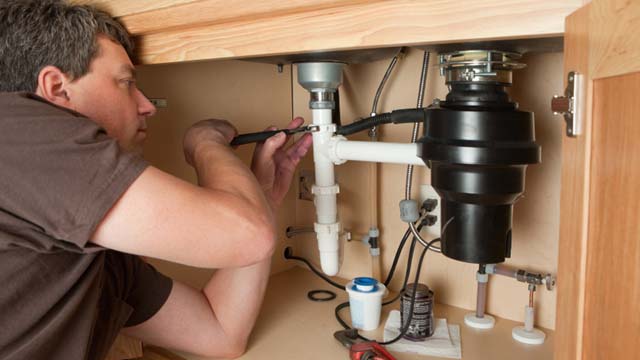An Comprehensive Guide to Fixing a Leaky Garbage Disposal
An Comprehensive Guide to Fixing a Leaky Garbage Disposal
Blog Article
We have come across this great article on Garbage Disposal Leaking From Bottom down the page on the internet and decided it made good sense to relate it with you here.

Garbage disposals are essential kitchen area devices that help in getting rid of food waste effectively. Nevertheless, a leaking waste disposal unit can be an irritating and unpleasant issue to handle. The good news is, numerous leaks can be repaired conveniently with a few straightforward steps. In this post, we will certainly go over exactly how to repair a leaking waste disposal unit efficiently.
Intro
Waste disposal unit are set up under cooking area sinks and are made to shred food waste into smaller items, enabling it to pass through the pipes system conveniently. While these gadgets are usually reputable, leaks can occur with time as a result of damage, loosened connections, or damage to the system.
Step-by-Step Guide to Taking Care Of a Dripping Garbage Disposal
Turn Off the Power
Prior to trying any kind of repair services, make certain that the power to the waste disposal unit device is shut off to avoid the threat of electric shock.
Find the Leak
Recognize the specific location of the leakage and figure out the cause
Tighten up Connections
Make use of a wrench to tighten any loose connections in between the disposal device and the pipes system.
Replace Seals or Gaskets
If the leak results from worn seals or gaskets, eliminate the old components and change them with brand-new ones.
Patching Cracks or Openings
For splits or openings in the disposal device, use epoxy or a suitable patching material to secure the damaged area.
Determining the Resource of the Leak
Prior to attempting to repair a leaking waste disposal unit, it is necessary to identify the source of the leak. This can usually be done via aesthetic evaluation or by conducting simple examinations.
Visual Inspection
Check the waste disposal unit unit meticulously for any type of indicators of water leakage. Pay very close attention to locations around seals, gaskets, and link factors.
Examining for Leakages
One method to check for leakages is by running water with the disposal unit and checking for any type of noticeable indicators of leak.
Common Causes of Leaks in Trash Disposals
Worn Seals and Gaskets
Seals and gaskets play a crucial role in stopping water from leaking out of the garbage disposal. In time, these components can deteriorate, leading to leaks around the disposal device.
Loose Links
The links in between the garbage disposal and the plumbing system can end up being loosened over time, creating water to leakage out throughout operation.
Cracks or Openings in the Disposal Device
Physical damage to the waste disposal unit, such as fractures or holes in the housing, can also result in leaks.
Devices and Materials Needed for Taking Care Of a Leaking Garbage Disposal
Before starting the repair work process, gather the necessary devices and products, including a screwdriver, adjustable wrench, plumbing's putty, replacement seals or gaskets, and epoxy or patching material for repairing fractures or holes.
Checking the Garbage Disposal After Repair Service
Once the repair work is full, test the waste disposal unit by running water with it to make sure that the leak has been resolved.
Preventive Maintenance Tips to Prevent Future Leaks
To stop future leaks, it is vital to execute regular upkeep on your waste disposal unit. This includes maintaining it tidy, staying clear of putting non-food products or tough items down the disposal, and occasionally looking for leakages or various other concerns.
Conclusion
Finally, fixing a leaking garbage disposal is a fairly straightforward procedure that can be completed with standard tools and products. By following the actions described in this article and practicing precautionary upkeep, you can keep your garbage disposal in good working problem and prevent expensive repair services in the future.
What to Do About a Leaking Garbage Disposal
A leaking garbage disposal often goes unnoticed until you confront a sopping cabinet, a foul-smelling puddle, or an audible drip-drip-drip from the unit. The fix can be frustrating, too, because the leak can stem from a number of components in the system. Fortunately, with a little sleuthing, you can zero in on the leak and—depending on the exact location—stop the icky oozing and repair the component that caused it. Worst case scenario, if it turns out that the garbage disposal must be replaced, installing a new one is a reasonable do-it-yourself task for those with basic plumbing skills. Read on to keep the cash you’d otherwise hand over to a pro.
Prepare to find the leak
Prior to testing the garbage disposal for leaks, unplug it at the wall outlet and turn off the power from the breaker box to prevent electrical shock. Then insert a watertight sink stopper into your sink drain and wipe the unit dry with a clean cloth. In any handy container, mix a few drops of food coloring into a few cups of water, and pour the dyed water onto the sink stopper to help you locate the leak.
Investigate the source
the top, where the disposal meets the sink drain the side, where the dishwasher hose or main drain pipe connects to the disposal or the bottom of the unit Inspect each of these locations while gliding a light-colored rag over the unit; the dyed water will readily show on the rag and reveal the location of the leak. If a leak isn’t immediately apparent, remove the sink stopper and pour a few more cups of dyed water down the sink drain, then check for leaks again. Leaks near the top of the unit are more likely to show themselves while the sink is plugged, while side and bottom leaks are more noticeable while the sink is unplugged.
The metal sink flange that sits directly inside the sink drain is typically sealed around the top with plumber’s putty (a clay-like sealant) and then secured from under the sink with bolts. If the plumber’s putty deteriorates, or the bolts loosen, the flange can no longer form a watertight seal between the sink drain and the disposal—which could cause a leak at the top of the unit.
To reseal the leaky flange, you must first detach the garbage disposal. Start by loosening the screws securing the main drain pipe to the disposal, then loosen the screws in the metal clamp securing the dishwasher hose to the disposal and detach the drain pipe and dishwasher hose from the disposal. Loosen the screws in the mounting ring that connects the disposal to the metal mounting assembly beneath the sink, then pull down the disposal and carefully set it on a clean, dry surface. Loosen the bolts in the mounting assembly with a wrench, then pull down the mounting assembly and set it near the disposal.

I was made aware of that write-up on Garbage Disposal Leaking From Bottom from someone on a different blog. Are you aware of anybody else who is fascinated about Why Is My Garbage Disposal Leaking From the Bottom?? Be sure promote it. Thank you for your time. Please stop by our blog back soon.
Details Report this page